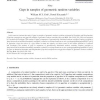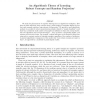2996 search results - page 43 / 600 » Numberings and Randomness |
AAIM
2008
Springer
13 years 12 months ago
2008
Springer
We give a randomized protocol for the classic cake cutting problem that guarantees approximate proportional fairness, and with high probability uses a linear number of cuts.
DM
2007
13 years 10 months ago
2007
In this note we continue the study of gaps in samples of geometric random variables originated in Hitczenko and Knopfmacher [Gap-free compositions and gap-free samples of geometri...
TIT
2002
13 years 9 months ago
2002
Abstract--A random matrix model is introduced that probabilistically describes the spatial and temporal multipath propagation between a transmitting and receiving antenna array wit...
VLSID
2005
IEEE
14 years 3 months ago
2005
IEEE
During pseudorandom testing, a significant amount of energy and test application time is wasted for generating and for applying “useless” test vectors that do not contribute t...
FOCS
1999
IEEE
14 years 2 months ago
1999
IEEE
We study the phenomenon of cognitive learning from an algorithmic standpoint. How does the brain effectively learn concepts from a small number of examples despite the fact that e...


